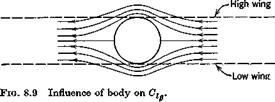INFLUENCE OF FUSELAGE ON Сц
The flow field of the body interacts with the wing in such a way as to modify its dihedral effect. To illustrate this, consider a long cylindrical body, of circular cross section, yawed with respect to the main stream. Consider only the cross-flow component of the stream, of magnitude F/S, and the flow pattern which it produces about the body. This is illustrated in Fig. 8.9. It
|
|
is clearly seen that the body induces vertical velocities which, when combined with the mainstream velocity, alter the local angle of attack of the wing. When the wing is at the top of the body (high-wing), then the angle-of-attack distribution is such as to produce a negative rolling moment: i. e. the dehedral effect is enhanced. Conversely, when the airplane has a low wing, the dihedral effect is diminished by the fuselage interference. The magnitude of the effect is dependent upon the fuselage length ahead of the wing, its cross-section shape, and the planform and location of the wing. Generally, this explains why high-wing airplanes usually have less wing dihedral than low-wing airplanes.












